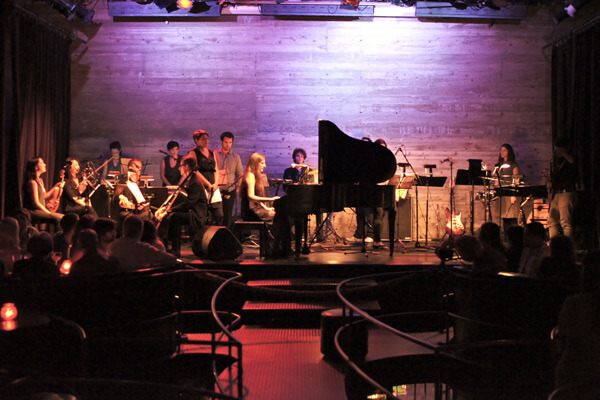On Friday, September 21, composer Rebecca Brandt held a release party for her album Numbers and Shapes at the swanky Galapagos venue in Brooklyn. She and her ensemble played every one of the 14 pieces from the album. Before her group’s performance were two other acts.

The Awakening Orchestra is a twenty-piece jazz big band, the brainchild of composer/conductor Kyle Saulnier. He juxtaposes traditional jazz structures with moments when the entire band plays freely, making “weird” noises with their instruments, often using extended techniques such as key-clicking and overblowing. Although effective as a compositional technique, this “free” jazz idea was sometimes a bit overused, and the overall impact of the Awakening Orchestra was a little bit too much constant blare and blast. Even an initially slow and somber love song gradually grew into the same stereotypical bombast as the rest of the set. There were some great solos—the whole band is made up of individually talented musicians. But they didn’t always cohere as a unit. When the final piece of the set required them to play in close, chorale-like harmonies, they were noticeably out of tune for the first several bars. However, despite my occasional reservations, Saulnier’s group was an excellent, energetic choice to kick off the evening.
Next up was You Bred Raptors?, a wordless rock ensemble with the unusual instrumentation of drums, eight-string electric bass, and amplified acoustic cello (both frontman Epileptic Peat and drummer Zach Schmidlein occasionally double on glockenspiel.) To make a long story short: the Raptors totally rocked the house. Although their act is quite theatrical, including different masks the musicians don for each successive song, they don’t actually need these gimmicks in order to succeed as a rock group. The wide range of the unusual “bass” instrument (which often sounds more like an electric guitar, and is capable of sounding chords), combined with the lyrical expressiveness of Bryan Wilson’s cello playing, gives the Raptors’ music surprising emotional depth. Meanwhile, Zach Schmidlein’s drumming is both energetic and varied, spanning the range from driving backbeat to subtle shuffles and unlooked-for syncopations.

Finally, at around 11 PM, the debut of Numbers and Shapes got started. Brandt assembled a crack team of 14 musicians, but arranging the works from the recorded album was still a challenge, as some of the studio tracks used 30+ instruments. Sad to say, perhaps owing to this contraction, the live performance was plagued by technical problems (the string players were often inaudible, for example), though these were mostly straightened out by the second half of the show. The high degree of musicality of the performers is not in question, however. All of them played their parts with care and feeling, and several of them rotated through a variety of instruments, showcasing the versatility of their talents.
Unfortunately, although Numbers and Shapes is ambitious and well-executed, both the live (and recorded) versions fall short on the level of composition. Many of the pieces are either too short (the shortest is around two minutes; the longest, five), or lacking in any sort of development of the primary motive, or both. To put it another way, this album can’t quite decide if it wants to be classical music or instrumental pop/rock: the harmonies are generally simple enough for pop, but, in spite of the driving drumwork, there isn’t really the syncopation of popular music. Some of the tracks, such as the mallet-percussion driven “Other Places,” also have a bit of a minimalist vibe to them, but lack the subtle shifting and transformation characteristic of the best entries in that genre.
Three pieces that exemplify this problematic lack of development are the opening track, “Staying Silent,” “The Clock Breaks At Three,” and “Jivko.” These tracks are organized around a single riff or ostinato that repeats throughout, with a variety of different instruments taking up the harmonies at different points, or simply adding another layer on top of what is already present. While repeating the same music with different orchestration is an oft-used technique, it’s no substitute for real variation as a piece unfolds. Although I found aspects of each piece engaging, such as the unexpected dissonance of the opening of “Clock”, I was ultimately frustrated again and again as I made my way through Numbers by the dull and predictable structures.

A few of the works have more interesting, self-referencing structures to them. I mentioned earlier that, at the concert, the strings were often hard to hear. One time they were able to be heard clearly, when they played alone on “Phylum,” was one of the best moments of the show—that track is also among the strongest on the album. First of all, because it utilizes only the four instruments of the string quartet, as opposed to the simple, pop-like layering of most of the other tracks, the changes in texture are striking: when, halfway through the piece, all but one violin drops out, it’s really breathtaking. That violin then plays a developmental section pizzicato which draws the listener in with its gradual, delicate softening. And, even though that pizzicato section is followed by a recapitulation of the main theme, it is noticeably different the second time, with the harmonies spaced differently. Furthermore, the pizzicato section is briefly recalled during the closing of the piece, giving it a sense of wholeness generally otherwise lacking on the album.
Don’t misunderstand: Numbers and Shapes contains many individual moments of great sonic beauty. Brandt knows her way around the different families of instruments, and uses them all in combinations that are both aurally pleasing and emotionally expressive. However, too many of the album’s pieces are long on orchestration but short on depth and complexity—not to mention simply being, well, short. They started out strong, but then didn’t go anywhere, and the whole experience left me wanting more.
Buy Rebecca Brandt’s “Numbers and Shapes” on Amazon.com
—
Matt Weber is a New York based composer, educator, and political slacktivist.
























